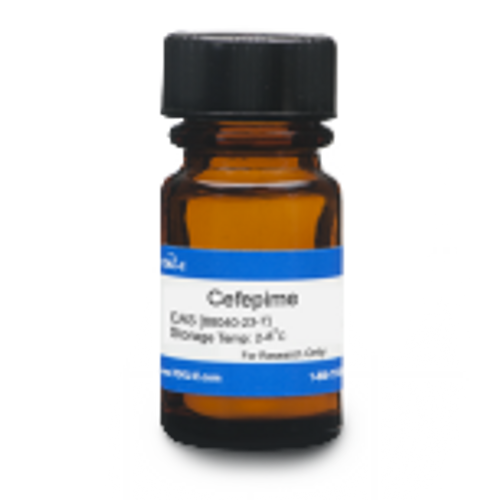Cefepime Hydrochloride is the hydrochloride salt of Cefepime. The addition of the hydrochloride salt enhances aqueous solubility. It is similar in potency to Cefepime, a broad-spectrum, fourth-generation cephalosporin antibiotic that was patented in 1982 by Bristol-Myers Squibb. Cefepime is bactericidal against a wide range of Gram-positive and Gram-negative bacteria, disrupting bacterial cell wall synthesis. It appears to be intrinsically more resistant to hydrolysis by β-lactamases and is commonly used in antimicrobial susceptibility testing. Cefepime Hydrochloride is soluble in water.
We also offer:
- Cefepime (C008)
| Mechanism of Action | Like β-lactams, cephalosporins interfere with penicillin binding protein (PBP) activity involved in the final phase of peptidoglycan synthesis. PBP’s are enzymes which catalyze a pentaglycine crosslink between alanine and lysine residues providing additional strength to the cell wall. Without a pentaglycine crosslink, the integrity of the cell wall is severely compromised and ultimately leads to cell lysis and death. Resistance to cephalosporins is commonly due to cells containing plasmid encoded β-lactamases. Interestingly, Cefepime is resistant to various β-lactamases encoded by otherwise resistant β-lactam bacteria strains. |
| Spectrum | Cefepime is a broad-spectrum antibiotic targeting a wide variety of naturally antibiotic resistant Gram-positive and Gram-negative bacteria. Some of these naturally resistant bacteria include Pseudomonas aeruginosa, Staphylococcus aureus, and Streptococcus pneumoniae. |
| Microbiology Applications | Cefepime Hydrochloride is commonly used in clinical in vitro microbiological antimicrobial susceptibility tests (panels, discs, and MIC strips) against Gram-positive and Gram-negative microbial isolates. Medical microbiologists use AST results to recommend antibiotic treatment options. Representative MIC values include:
Cefepime was used in a MALDI-TOF MS-based direct-on-target mirodroplet growth assay as part of a screening panel for rapid detection of ESBL, and AmpC β-Lactamases in Enterobacterales. (Correa-Martinez et al, 2019). |
| Cancer Research Applications | Cefepime (50mM) was mixed with 8 different metal salts (copper, zinc, cobalt, nickel, cadmium, chromium, iron, and manganese ) in a 1:1 ratio and evaluated for proteasome-inhibitory and anti-proliferative properties using MDA-MB‑231 human breast cancer cells. The complex with manganese had the highest inhibition of cell proliferation and proteasome activity. The complex induced apoptosis in a dose-and time-dependent manner and has the potential for use as an antitumor agent (Zhang et al, 2015). |
| Molecular Formula | C19H25ClN6O5S2 · HCl · H2O |
| Identification | E isomer: ≤0.2% Any individual impurity: ≤0.2% |
| References |
Georgopapadakou NH and Bertasso A (1993) Mechanisms of action of cephalosporin 3'-quinolone esters, carbamates, and tertiary amines in Escherichia coli. Antimicrob. Agents. Chemother. 37(3):559-565 Cefepime (TOKU-E) Correa-Martinez C, Idelevich EA, Sparbier K, Kostrzewa M, and Becker K (2019) Rapid detection of extended-spectrum B-lactamases (ESBL) and AmpC B-Lactamases in Enterobacterales: Development of a screening panel using the MALDI-TOF MS-based direct-on-target microdroplet growth assay. Front. Microbiol. 10:13 PMID 30733710 |
| MIC | Bacillus cereus| 250 - >500|| Bacillus macerans (A199)| 15.62|| Bacillus pumilus| 31.25|| Bacillus subtilis| 62.5 - 125|| Brucella abortus (A77)| 62.5 - 125|| Cedecea davisae (F2)| 31.25|| Clavibacter michiganense (A227)| 15.62 - 16.62|| Enterobacter cloacae (A135)| 31.25|| Enterococcus faecalis (ATCC 29122)| 31.25 - 62.5|| Escherichia coli| 15.6 - 125|| Klebsiella pneumonia| 31.2 - 125|| Morganella morganii (F4)| 31.25|| Proteus mirabilis| 62.5|| Proteus vulgaris| 15.62 - 125|| Pseudomonas aeruginosa| 15.62 - >500|| Pseudomonas putida| 125|| Pseudomonas syringae| 31.25 - 125|| Salmonella cholerasuis arizonae (F7)| 62.5|| Salmonella enteritidis (ATCC 13076)| 31.25 - 62.5|| Salmonella typhi| >500|| Salmonella typhimurium| >500|| Serratia plymuthica (F8)| 31.25|| Shigella sonnei (F9)| 31.25|| Staphylococcus aureus| 7.8 - 62.5|| Staphylococcus epidermidis (A233)| 15.62 - 62.5|| Staphylococcus hominis (F10)| 125|| Streptococcus pyogenes| 31.25 - 125|| Xanthomonas campestris (A235)| 31.25|| Yersinia enterocolitica (F11)| 16.62|| |








